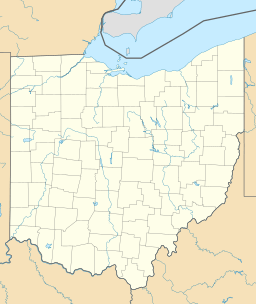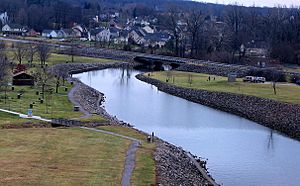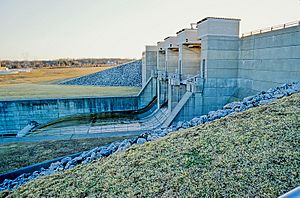Alum Creek Lake facts for kids
Quick facts for kids Alum Creek Lake |
|
|---|---|

Alum Creek Dam and Lake. View is to the northwest.
|
|
| Location | Delaware County, Ohio |
| Coordinates | 40°11′09″N 82°58′00″W / 40.185718°N 82.966636°W |
| Type | impound |
| Primary inflows | Alum Creek |
| Primary outflows | Alum Creek |
| Basin countries | United States |
| Built | September 1974 |
| Surface area | 5 sq mi (13 km2) |
| Max. depth | 68 ft (21 m) |
| Water volume | 134,815 acre⋅ft (166,292,000 m3) |
Alum Creek Lake is a large lake in Delaware County, Ohio, United States. It's not a natural lake; it was created by people! This man-made lake, also called a reservoir, was finished in 1974. It covers about 5 square miles (13 square kilometers) and can hold a lot of water.
Contents
Building the Alum Creek Dam (1970–1974)
The Alum Creek Dam was built between 1970 and 1974. It was constructed on Alum Creek, which is a smaller stream that flows into Big Walnut Creek, and then into the Scioto River.
The dam is a huge wall made of packed earth. It's about 10,000 feet (3,048 meters) long and can be as tall as 93 feet (28 meters). The dam has a special part called a spillway. This is where extra water can flow out safely if the lake gets too full.
The spillway has three very large gates, called tainter gates. These gates are 34 feet (10 meters) tall and 25 feet (7.6 meters) wide. They help control how much water leaves the lake.
Making the Dam Stronger (1975–1978)
After the dam was finished, engineers from the US Army Corps of Engineers checked it. They became concerned about the ground under the spillway. The rock there, called Ohio Black Shale, had some weak spots. They worried that a part of the spillway might slowly slide forward. If this happened, it could cause problems for the dam.
Testing the Ground
To understand the problem better, engineers drilled 12 holes into the ground in front of the spillway. They found a soft, clay-like layer about 9 feet (2.7 meters) below the dam's base. Tests showed that this weak layer could indeed cause the spillway to shift.
Adding Strong Anchors
To prevent any movement, engineers decided to add seven special anchors deep into the bedrock. Each anchor was made of strong steel cables. These cables were placed into the drilled holes and then filled with concrete at the bottom. Next, they used powerful machines to pull the cables very tight. This made the anchors hold the spillway firmly in place. Finally, the rest of the holes were filled with a special cement mixture called grout.
The work to install these anchors began in June 1977 and was finished by 1978. This project made the Alum Creek Dam much safer and stronger.
The Big Flood of January 2005
On January 16, 2005, Alum Creek Lake reached its highest water level ever since it was built. The water was about 17 feet (5 meters) higher than normal! Even with this high water, the dam's main gates did not need to be opened. The water was controlled through the regular discharge pipe.
This huge flood happened because a lot of rain fell across Central Indiana and Ohio. Between January 4 and 14, 2005, about 5 to 8 inches (13 to 20 cm) of rain poured down. This rain, combined with melting snow and already wet ground, caused record-breaking runoff into many lakes and rivers. Other lakes in Ohio also saw very high water levels during this time.
Fun Things to Do at Alum Creek Lake
Alum Creek Lake is a very popular spot for both local people and tourists. There are many fun activities to enjoy:
- Fishing: The lake is home to many kinds of fish.
- Picnicking: There are great spots to have a picnic with family and friends.
- Boating: You can enjoy boating on the large lake.
- Hiking: There are trails around the lake for hiking and exploring nature.
See Also
- Barnes, William D., Anchoring of Spillway Monoliths, Alum Creek Lake, Ohio, Concrete Structures Repair and Rehabilitation, Vol C-82-1, September, 1982, US Army Engineer Waterways Experiment Station, Vicksburg, MS.
Images for kids









